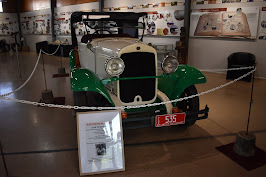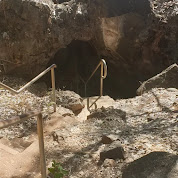Exploring the History of Katherine NT.
Every place you visit, no matter where you are, has a history. Have you ever wondered how a place started or what it was like when the pioneers first rode out here many years ago? These two green frogs, we have an interest in history no matter where we go, so our first place to visit in Katherine is the museum.
 |
| Old trucks and a Blitz |
When you first enter the main part of the museum you are greeted by a lovely lady who tells you all about what you can see in the different sheds and can answer your questions about the history of Katherine. The main building houses items from World War 2 when it came to the region, a selection of wedding dresses from years gone by, clothing from past time worn by everyday women and the armed forces. A section of Indigenous spears, hunting spears, boomerangs and didgeridoos. There are photos of when a flood came to Katherine wreaking havoc in the area, some would say we are in the outback how can it flood. Unfortunately, it isn't just a problem that happens on the coast of Australia and with the land so flat out here the water can flow for kilometres in any direction.
 |
| Saddles and a painted cow horn |
 |
| 1928 Chrysler |
There is a shed that houses information about the overland telegraph line that was built from Adelaide to Darwin.
What did it take you might wonder:
- 36000 poles
Telegraph poles and ceramic holder - 400-pound galvanized iron (8-gauge wire)
- 11 repeater stations.
- Submarine cable. Java to Darwin
- Supply Vessel
- Horses and Bullocks
- Teamsters
- Drovers enroute for a fresh supply
- Rations- Rum, flour, meat, rice, salt, mustard, pepper, sugar, tea, biscuits, tobacco, dried vegetables, and soap.
They suffered:
- Sunburn and exhaustion
- sunstroke
- snake bites
- eye infections
- tropical diseases and deaths.
When you think about the work today, it was extremely hard and probably not a lot of pay. How many people today would do this kind of work?
 |
| Telephone exchange |
In one of the sheds, you will find old telephones from an old rotary winding ones (which I used to play with as a child) to the Nokia which nearly everyone had in their day, to the fashionable ones on the wall with the extra-long cord so you could sit on the lounge or floor while chatting to your friends. There is also an old machine where you can insert 2c and 5c for a stamp. Considering what they cost now it is a huge difference. There are some old telegraph poles and ceramic wire holders too. Once in the early days telephone exchanges looked like a mixture of wires. Imagine if they were still being used today. More people have phones and there would be so many wires to remember where they went and who they were for.
 |
| Bush kitchen |
 |
| Clyde Fenton's Airplane |
One of the pioneers of Katherine, Clyde Fenton, earned his pilot's licence in order to join the Royal Flying doctor Service, but the founder Reverend John Flynn, had a policy of not using doctors as pilots.
As a result, Fenton privately raised money for an aircraft. In March 1934 he arrived in Katherine as a Government Medical Officer. He started an aerial ambulance rescue service which grew into the Northern Territory Aerial Medical Service. A service that is much appreciated today and many people rely on this service to keep them well and able to access medical services like a hospital and specialists while they currently live in remote areas.
Out the front of the buildings there is a selection of graders, bulldozers, Utes, trucks and farm equipment that was used in the area. There is even an old Blitz, which my grandfather had back when my mother was younger. I know of one green frog who enjoyed the old tractors and trucks.
 |
| Various tractors, bulldozers and vehicles |
This is one museum that we enjoyed visiting and learning about history of the area and Katherine.
🐸 We love learning about history and what has helped to shape our nation. History can be fun when people get to experience it with the tools, vehicles and implements of the day.




Comments
Post a Comment